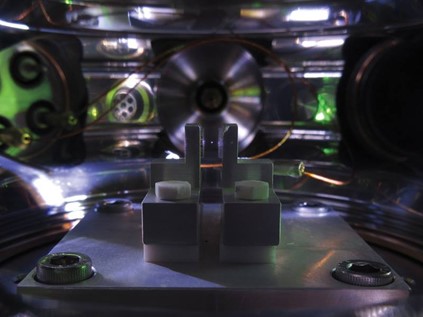According to the IPP, researchers succeeded in extracting a negative hydrogen ion current density of almost 300 amperes per square meter from ELISE for 600 seconds—a world record. This enabled them to increase the previously possible pulse length for such current densities by more than tenfold. For shorter pulses lasting 10 seconds, 330 amperes per square meter were generated, which is also a world record.
Plasma heating: At ITER, the plasma must be heated to a temperature of 150 million degrees Celsius. Around half of the required heating power is to come from an NBI, which shoots fast hydrogen atoms into the plasma. The energy of the injected hydrogen is transferred to the plasma by means of collisions.
To do this, hydrogen ions are first generated, extremely accelerated in an electric field, and then neutralized to enter in the magnetic cage of the ITER tokamak where the plasma is confined. Such a powerful NBI heating—two particle beams are to deliver 16.5 megawatts each—has never been built before.
The aim of the Max Planck ELISE experiments is to generate a hydrogen ion beam with a reliably high current density and demonstrate quasicontinuous operation. The ion source of ELISE is half the size of the ion source for ITER.
What it means: The record ion current density means that ELISE has already achieved the ITER target, even though only a maximum of 75 percent of the high-frequency power available at ITER is available to generate the ion source plasma at the experimental testing facility.
“Both values represent a real breakthrough for the development of the ITER NBI system,” said IPP scientist Dirk Wünderlich. “We are now achieving the target values that are required for the first ITER operating phase with deuterium-tritium fuel.”
Ion sources: A central component of the ITER NBI system are ion sources in which negative (deuterium) ions are produced and then extracted and accelerated. These ion sources are roughly the size of a door: At ITER, the cross-section of such an ion beam should have a rectangular area of 1 meter by 2 meters. At ELISE, it is half the size (a square with an edge length of one meter).
The extraction of ITER-relevant negative ion beams from such ion sources is an extremely challenging task, as the ion beam must remain homogeneous over the entire surface and temporarily stable during pulses lasting several hundred seconds. The quantity of electrons inevitably extracted during the process must remain as small as possible, as these would cause damage to the extraction grid in the NBI system.
The current pulse lengths of 10 minutes were only possible because the researchers have recently been able to make significant progress in controlling these electrons, according to the IPP. This now prevents the grids from overheating.
Next steps: “These requirements were consistently met during the world-record experiments in ELISE,” said Ursel Fantz, IPP division head. “The next step will be to develop operating scenarios with which the ITER values can be achieved quickly and reliably.”
Following the successes with hydrogen, IPP researchers also want to achieve the values with deuterium ions—a requirement for later operating phases of ITER. The ion current densities now achieved should then be maintained for up to 60 minutes.
“ELISE is technically designed to achieve these goals,” said Fantz. Further world records are therefore planned for the coming years at the IPP experimental testing facility.











